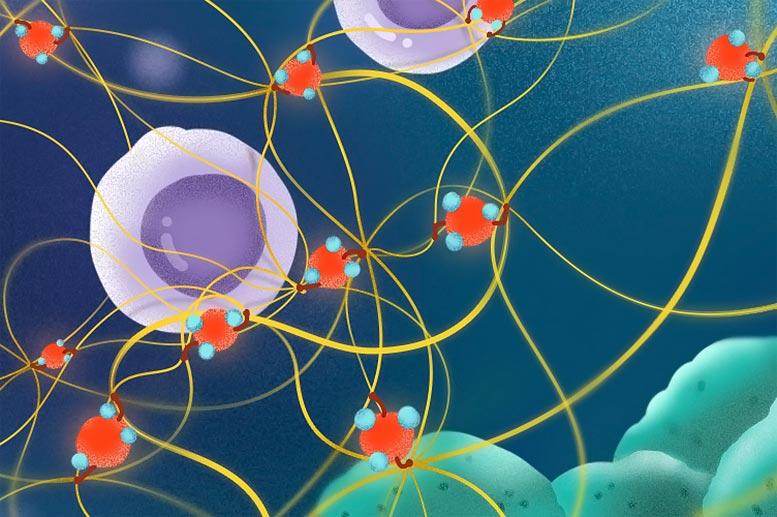博文
中国科学家发现空气污染如何改变肺组织,增加癌症易感性
 精选
精选
||
中国科学家发现空气污染如何改变肺组织,增加癌症易感性
诸平
Inhaled fine particulate matter (shown here in red) pulls strings of collagen to disturb the immune defense in mice with lung cancer cells. This activity delays the movement of cytotoxic T-cells (purple) as they migrate towards the cancer cells (green) to destroy them. Credit: Wang et al. (CC BY 4.0)
据《e生命》(eLife)2022年4月21日提供的消息,来自中国南京大学(Nanjing University, China)和中国澳门大学(University of Macau, China)的科学家,发现了空气污染如何改变肺组织,增加癌症易感性(Scientists Discover How Air Pollution Alters Lung Tissue, Increasing Cancer Susceptibility)。此研究结果突出了一个预防空气污染引起的肺部疾病的潜在新目标。
上述图示是吸入的细颗粒物(如图中红色部分所示)会拉动胶原蛋白(collagen)的线,扰乱有肺癌细胞的小鼠的免疫防御。这种活动会延迟细胞毒性T细胞(紫色)的移动,因为它们会向癌细胞(绿色)移动以摧毁癌细胞。相关研究结果于2022年4月19日已经在《e生命》杂志网站发表——Zhenzhen Wang, Ziyu Zhai, Chunyu Chen, Xuejiao Tian, Zhen Xing, Panfei Xing, Yushun Yang, Junfeng Zhang, Chunming Wang, Lei Dong. Air pollution particles hijack peroxidasin to disrupt immunosurveillance and promote lung cancer. eLife, 19 Apr 2022, 11: e75345. DOI: 10.7554/eLife.75345. https://elifesciences.org/articles/75345
在此论文中,科学家们发现了一种解释微小空气污染颗粒如何诱发肺癌的机制。这一发现可能为预防或治疗导致该疾病的早期肺部病变的新技术铺平道路。
空气污染物中发现的微小可吸入细颗粒物(fine particulate matter简称FPM)已被认定为第一类致癌物,对全球健康构成重大威胁。然而,FPM的致癌机制尚不清楚。
南京大学生命科学学院药物生物技术国家重点实验室(State Key Laboratory of Pharmaceutical Biotechnology, School of Life Sciences, Nanjing University, Nanjing, China)的副研究员、上述论文的第一作者王珍珍(Zhenzhen Wang)解释道:“尽管FPM有可能导致突变,但最近的研究表明,FPM并不直接促进——甚至可能抑制——肺癌细胞的生长。这表明FPM可能通过支持肿瘤生长的间接手段导致癌症。例如,一些研究表明FPM可以阻止免疫细胞移动到需要它们的地方。”王珍珍是南京大学(Nanjing University简称NJU)的副研究员(associate researcher),在澳门大学奖学金的资助下,她在南京大学和澳门大学的实验室之间进行了这项研究。”
为了探索这种可能性,王珍珍和团队其他成员从中国的七个地方收集了FPM样本,并研究了它对防御肿瘤生长的主要免疫细胞——细胞毒性T细胞(cytotoxic T-cells简称CTLs)的影响。给小鼠注射未暴露于FPM的肺癌细胞后,CTLs被招募到肺中破坏肿瘤细胞。相比之下,在肺暴露于FPM的小鼠中,CTLs的浸润被延迟了——这可能允许肿瘤细胞在肺组织中形成。
为了研究为什么CTLs在暴露于FPM的肺中没有那么快进入肺,研究小组研究了CTLs本身和肺组织结构。他们发现暴露于FPM的CTLs仍然保持其迁移能力,但暴露于FPM极大地压缩了肺组织结构和免疫细胞在其中移动的空间。胶原蛋白水平也高得多,胶原蛋白是一种为细胞和组织提供生物力学支持的蛋白质。当研究小组在暴露于FPM的小鼠肺组织中研究CTLs的运动时,CTLs很难移动,而未处理的组织中的CTLs可以自由移动。
对该组织的进一步分析表明,结构变化是由胶原蛋白亚型胶原IV(collagen IV)的增加引起的,但研究小组仍然不知道FPM是如何引发这一变化的。当他们更仔细地观察IV型胶原蛋白的结构变化以及产生这些变化的酶——过氧蛋白(peroxidasin)时,他们找到了答案。这种酶驱动一种特定类型的交联,接触FPM被发现会导致肺部组织恶化。
王珍珍说:“最令人惊讶的发现是这一过程发生的机制。过氧蛋白酶(peroxidasin enzyme)粘在肺中的FPM上,增加了它的活性。总之,这意味着无论FPM进入肺的哪个部位,过氧蛋白酶活性的增加都会导致肺组织的结构变化,从而将免疫细胞拒之门外,使其远离生长中的肿瘤细胞。”
上述论文的共同通讯作者之一、南京大学生命科学学院教授董磊(Lei Dong)总结道:“我们的研究揭示了吸入细颗粒物促进肺肿瘤发展的一种全新机制。我们提供的直接证据表明,粘附在细颗粒物上的蛋白质可以造成重大的不利影响,引发致病活性。我们发现过氧蛋白是肺组织中这种作用的中介,这确定了它是预防空气污染引起的肺部疾病的一个特定的和意想不到的目标。”
本研究得到了中国国家自然科学基金(National Natural Science Foundation of China:31971309;32001069;81973273)、江苏省自然科学基金(Natural Science Foundation of Jiangsu Province: BK20200318)、澳门科技发展基金(Fundo para o Desenvolvimento das Ciências e da Tecnologia: FDCT 0018/2019/AFJ,0060/2020/AGJ)、澳门大学项目(Universidade de Macau: MYRG2020-00084-ICMS)、国家自然科学基金—国际合作与交流基金(National Natural Science Foundation of China—the funds for the International Cooperation and Exchange: 31961160701)以及南京大学—中央高校基础研究基金(Nanjing University—the Fundamental Research Funds for the Central Universities: 020814380115)的资助。
上述介绍,仅供参考。欲了解更多信息,敬请注意浏览原文或者相关报道。
Although fine particulate matter (FPM) in air pollutants and tobacco smoke is recognized as a strong carcinogen and global threat to public health, its biological mechanism for inducing lung cancer remains unclear. Here, by investigating FPM's bioactivities in lung carcinoma mice models, we discover that these particles promote lung tumor progression by inducing aberrant thickening of tissue matrix and hampering migration of anti-tumor immunocytes. Upon inhalation into lung tissue, these FPM particles abundantly adsorb peroxidasin (PXDN) - an enzyme mediating type IV collagen (Col IV) crosslinking - onto their surface. The adsorbed PXDN exerts abnormally high activity to crosslink Col IV via increasing the formation of sulfilimine bonds at the NC1 domain, leading to an overly dense matrix in the lung tissue. This disordered structure decreases the mobility of cytotoxic CD8+ T lymphocytes into the lung and consequently impairs the local immune surveillance, enabling the flourishing of nascent tumor cells. Meanwhile, inhibiting the activity of PXDN abolishes the tumor-promoting effect of FPM, indicating the key impact of aberrant PXDN activity on the tumorigenic process. In summary, our finding elucidates a new mechanism for FPM-induced lung tumorigenesis and identifies PXDN as a potential target for treatment or prevention of the FPM-relevant biological risks.
https://blog.sciencenet.cn/blog-212210-1335379.html
上一篇:新材料使太阳能电池更便宜,更容易制造
下一篇:科学家们把氢分子变成了量子传感器
